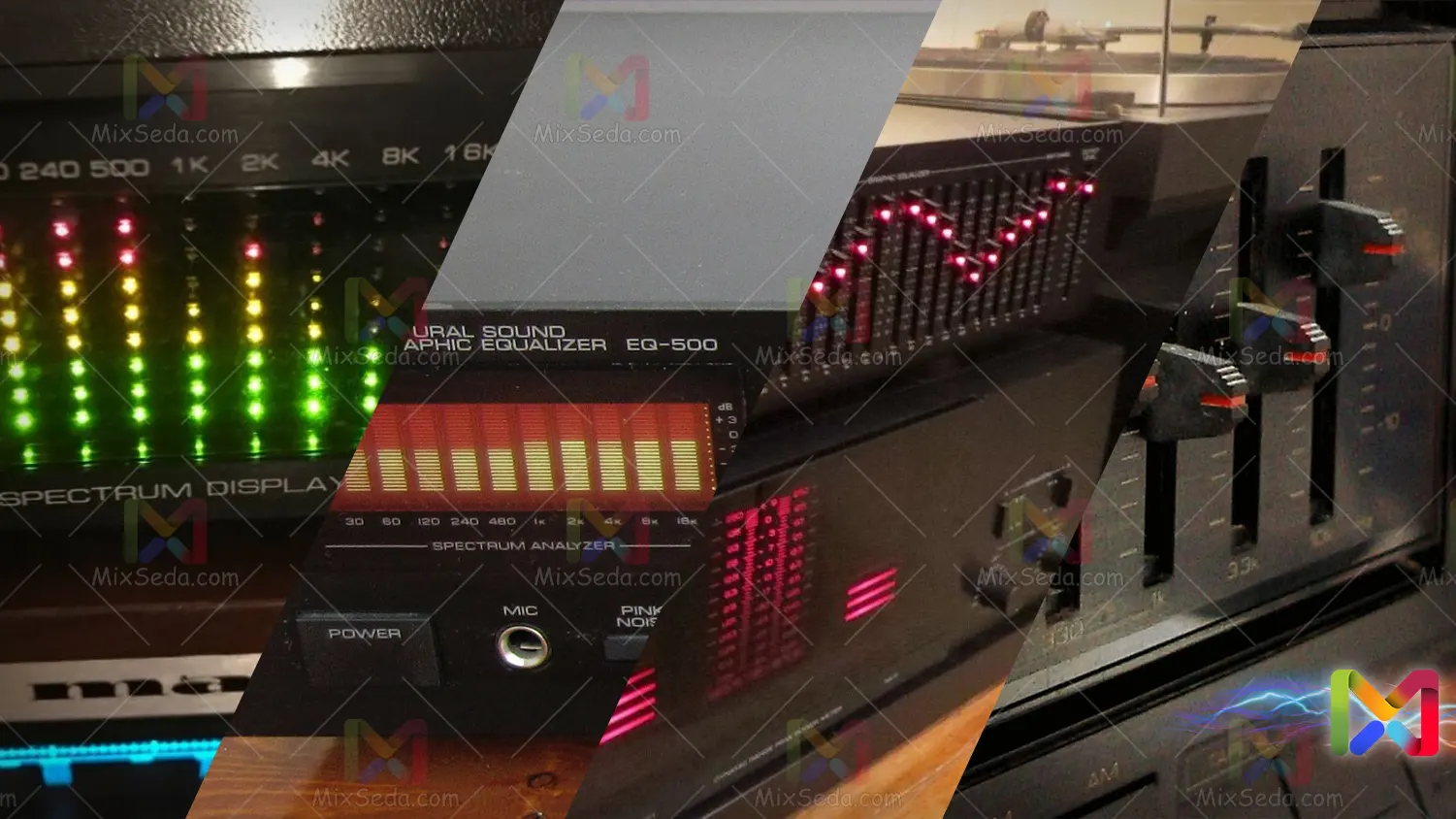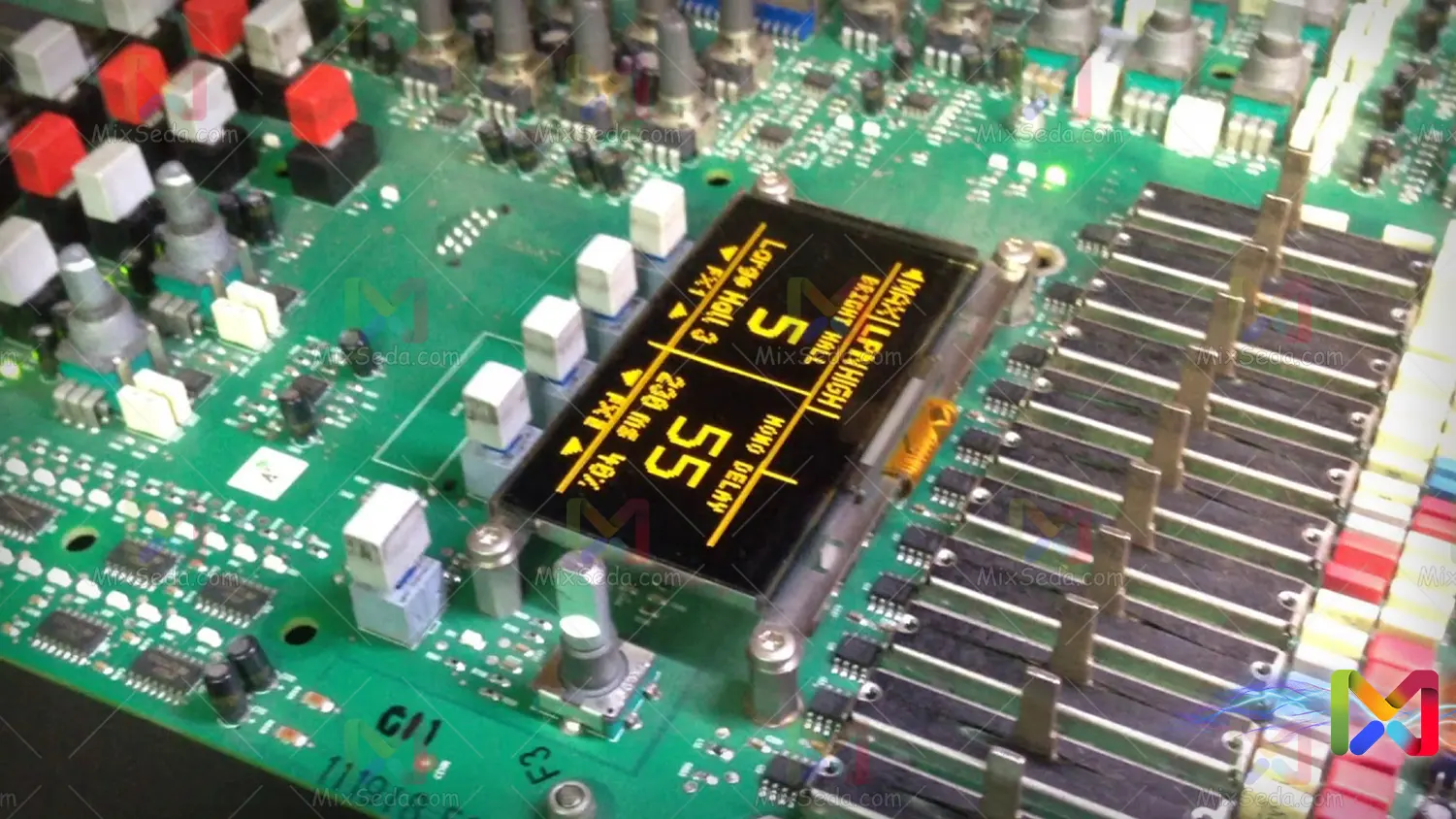
Equalizer and its types
As far as I know, we have two types of equalizers. One of them is the graphic equalizer.
- Parametric equalizer
- Graphic equalizer
As I explained in previous articles, the parametric equalizer is made up of multiple volumes. And as the name suggests, you can get the sound you want by setting a number of parameters across these volumes.
In graphic equalizers, the sound equalization is done more accurately, and in fact you can tell that your hands are more open to equalize the sound. This type of equalizer was widely seen as analog on older radios, but has now been replaced by digital equalizers.
The equalizer you see in home audio and car recorders is also a kind of parametric or graphic equalizer, except that it is digitally applied to the sound, just like digital mixers.
What is a graphic equalizer?
Graphic equalizers usually contain 10 to 15 audio channels. It goes without saying that each of these channels is stereo. Usually each channel of these graphic equalizers can be changed from 10 to 15 decibels (db).
In Dynacord mixers, graphic equalizers include 11 channels. Each of these channels can be increased or decreased by 10 decibels (db). In previous versions the number of channels was not more than 10.
In PowerMixer 502 Dynacord, the number of channels of the graphic equalizer is 7 toast. Usually in equalizers, the high frequency (high - low sound) is on the right, the middle frequency (medium - medium) is in the center, and the low frequency (low - low sound) is on the left.

Work with the graphic equalizer
High frequency
The 12Khz frequency channel includes the high frequency which determines the following sound in the output sound. The sound becomes lower as the frequency decreases by 12Khz.
High frequency range (treble - bass sounds)
The 6.3 Khz to 2.5 Khz frequency range is the range of the following frequencies up to the middle frequencies. This range includes the frequencies that make up the following sound. You can make the output sound clearer by amplifying this frequency range.
Be careful not to overdo it with this graphic equalizer. Increasing this range creates feedback or whistling in the bands. Especially when the volume (Hi) in the parametric equalizer is high.
Mid frequency range (mid-midrange)
The frequency range from 1.6Khz to 630Hz is the frequency range of the middle range. This range is used to relieve hoarseness and fill in sound. Normally I always try to keep this range of sounds below the two frequencies of high and low frequency.
Blocking the channels in this area causes the sound to become hoarse or the sound to become nasal.
Low frequency range (bass - bass sound)
The frequency range from 400 Hz to 125 Hz is the range of frequencies in between the bass frequency. As this range increases, the volume increases or, in a simpler interpretation, the volume of the bass increases.
When you reduce the channels associated with this range, the sound becomes darker and the volume disappears.
Low frequency
The 63 Hz frequency channel includes the low frequency which determines the bass sound in the output sound. As this channel increases, the sound becomes thinner and hollow and as this frequency decreases, the sound becomes hollow.
Equalization setting
The important thing here is that we don't have a unique equalization. Or we have no equal to say that this is the best of all and we have no better than this equal. You have to adjust the equalizer channels according to the singer's sound and the sound you want to have output.
Of course, the type of sound emitted also depends on the following factors:
- Microphone type
- Microphone EQ type (on some microphones)
- Type of parametric equalization
- Type of speakers
- speakers equalization (only in active speakers)
- And most importantly, the genre of the singer's voice
Knowing the types of sound depends on your personal experience.
Types of graphic equalizers
There are well-known examples of graphic equalizers, with which professionals are almost generally familiar and in which each of them is used.
Usually the name given to these equalizers is the use and type of sound you will get as a result of adjusting these equalizers.
Some of these equations include the following:
- Pop
- Inhabit
- Club
- Rock
- Bass
- High
- Vocal
- Powerful
- Dance
- Soft
- Party
- Classic
- Jazz
Apply a graphic equalizer to the outputs
In mixers like Dynacord, you'll be able to determine which of your outputs your equalizer will be applied to. Of course, not all hands are open on all exits.
You can only specify to apply the graphic equalizer to the following three outputs.
- Main outputs
- Mon 1 outputs (Mon 1)
- Mon 2 outputs (Mon 2)
If you look under the graphic equalizer in Dynacord mixers, you will see that there are three lights. At the top of these lights you can see the words "Graphic Eq To". These lights determine which graphic equalizer output of the device is applied.
That is, if the equalizer is assigned to the master, then the green light will turn on. And if you assign the equalizer to our channels (Mon 1 / Mon 2), the yellow lights come on.
I stress once again that the graphic equalizer outputs are never applied to the following outputs:
- AUX outputs
- Master B output
- Effects send outputs
In digital mixers, your hand is much more open to applying digital and graphic equalizers to the audio output channels.
Frequent questions
Some of Rajab's friends have asked a number of questions in this article, which I think I need to explain in this section. One thing to note here is that reading this section is not part of the tutorial and I may need to explain the past again.
Graphic equalizer setting
One of the most important parts of mixing and adjusting the sound is the question of sound equalization. The sound equalizer is very important in live performances and mixing. There are many benefits to sound equalization, including:
Separation of frequency ranges from each other
For example, in concerts, a separate equalization is applied to each of the microphone outputs so that each microphone does not pick up the sound of other instruments and feed them into the system.
This type of sound separation has several advantages:
First, you can easily check the sounds in the live broadcast. Secondly, for the record, the sound is recorded separately and is easier to mix.
Third, it is easier and more accurate to apply the effect to any sound.
Amplify the sound
One of the most important uses of an equalizer is the amplification of sound. Of course, this does not mean amplifying the sound of the amplifier. For example, you can mute or lower the singer's voice, in fact you are amplifying different frequencies of the singer's voice.
Preventing distortion of sound
There are several reasons for sound distortion, one of which is improper sound equalization. If you equalize the sound input to the mixer based on the equalization of each speaker, the speakers are less likely to whistle or the sound will be distorted during live broadcast.
Adjusting the sound equalizer, both graphic and parametric, requires experimental knowledge. No matter how much you read about the types of EQs, I don't think you will learn, or rather become a pro, unless you do it yourself.
Dynacord equalizer adjustment
The equalizer setting of the Dinacor device is not very different from that of other analog devices. You just have to pay attention to the fact that in both Dynacord mixers and other mixers, changing one millimeter of each of these bands (equalizer feeder) is important and affects the sound output.
So be careful to equalize the sound and especially to change the equalizer when playing the sound. Especially when playing audio because the changes in the sound are very noticeable right now.
Adjusting the Dinacord 1000 equalizer
The Dynacord Model 1000 has 11 bands for graphic equalizer adjustment. 6 sound files of this mixer have 4 volumes of parametric equalizer and 4 sound files of this mixer have 3 volumes of parametric equalizer.
Dinacord 600 equalizer adjustment
The old Dynacord Model 600 has 7 units and the new Dynacords Model 600 has 9 bands for adjusting the graphic equalizer. This device has 8 sound files or sound lines, all featuring 3 parametric EQ volumes.
There is no Khz volume in the Dynacord 600's parametric equalizer and it is not possible to define a variable value to define the volume of the mids. In other words, Mid is always at a certain kilohertz.
